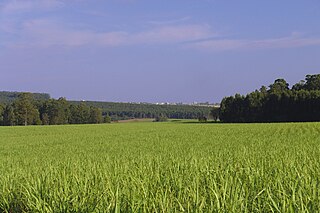Bioproducts or bio-based products are materials, chemicals and energy derived from renewable biological material. [1] [2] [3]
Biological resources include agriculture, forestry, and biologically derived waste, and there are many other renewable bioresource examples.
One of the examples of renewable bioresources is lignocellulose. Lignocellulosic tissues are biologically derived natural resources containing some of the main constituents of the natural world. [4]
Conventional bioproducts and emerging bioproducts are two broad categories used to categorize bioproducts. Examples of conventional bio-based products include building materials, pulp and paper, and forest products. Examples of emerging bioproducts or biobased products include biofuels, bioenergy, starch-based and cellulose-based ethanol, bio-based adhesives, biochemicals, bioplastics, etc. [8] [9] Emerging bioproducts are active subjects of research and development, and these efforts have developed significantly since the turn of the 20/21st century, in part driven by the price of traditional petroleum-based products, by the environmental impact of petroleum use, and by an interest in many countries to become independent from foreign sources of oil. Bioproducts derived from bioresources can replace much of the fuels, chemicals, plastics etc. that are currently derived from petroleum [10]
Bioproducts engineering (also referred to as bioprocess engineering) refers to engineering of bio-products from renewable bioresources. This pertains to the design, development and implementation of processes, technologies for the sustainable manufacture of materials, chemicals and energy from renewable biological resources.

Biofuel is a fuel that is produced over a short time span from biomass, rather than by the very slow natural processes involved in the formation of fossil fuels, such as oil. Biofuel can be produced from plants or from agricultural, domestic or industrial biowaste.
Cellulosic ethanol is ethanol produced from cellulose rather than from the plant's seeds or fruit. It can be produced from grasses, wood, algae, or other plants. It is generally discussed for use as a biofuel. The carbon dioxide that plants absorb as they grow offsets some of the carbon dioxide emitted when ethanol made from them is burned, so cellulosic ethanol fuel has the potential to have a lower carbon footprint than fossil fuels.

A biorefinery is a refinery that converts biomass to energy and other beneficial byproducts. The International Energy Agency Bioenergy Task 42 defined biorefining as "the sustainable processing of biomass into a spectrum of bio-based products and bioenergy ". As refineries, biorefineries can provide multiple chemicals by fractioning an initial raw material (biomass) into multiple intermediates that can be further converted into value-added products. Each refining phase is also referred to as a "cascading phase". The use of biomass as feedstock can provide a benefit by reducing the impacts on the environment, as lower pollutants emissions and reduction in the emissions of hazard products. In addition, biorefineries are intended to achieve the following goals:

Bioenergy is energy made or generated from biomass, which consists of recently living organisms, mainly plants. Types of biomass commonly used for bioenergy include wood, food crops such as corn, energy crops and waste from forests, yards, or farms. The IPCC defines bioenergy as a renewable form of energy. Bioenergy can either mitigate or increase greenhouse gas emissions. There is also agreement that local environmental impacts can be problematic.
Bioplastics are plastic materials produced from renewable biomass sources, such as vegetable fats and oils, corn starch, straw, woodchips, sawdust, recycled food waste, etc. Some bioplastics are obtained by processing directly from natural biopolymers including polysaccharides and proteins, while others are chemically synthesised from sugar derivatives and lipids from either plants or animals, or biologically generated by fermentation of sugars or lipids. In contrast, common plastics, such as fossil-fuel plastics are derived from petroleum or natural gas.
Bioconversion, also known as biotransformation, is the conversion of organic materials, such as plant or animal waste, into usable products or energy sources by biological processes or agents, such as certain microorganisms. One example is the industrial production of cortisone, which one step is the bioconversion of progesterone to 11-alpha-Hydroxyprogesterone by Rhizopus nigricans. Another example is the bioconversion of glycerol to 1,3-propanediol, which is part of scientific research for many decades.

Lignocellulose refers to plant dry matter (biomass), so called lignocellulosic biomass. It is the most abundantly available raw material on the Earth for the production of biofuels. It is composed of two kinds of carbohydrate polymers, cellulose and hemicellulose, and an aromatic-rich polymer called lignin. Any biomass rich in cellulose, hemicelluloses, and lignin are commonly referred to as lignocellulosic biomass. Each component has a distinct chemical behavior. Being a composite of three very different components makes the processing of lignocellulose challenging. The evolved resistance to degradation or even separation is referred to as recalcitrance. Overcoming this recalcitrance to produce useful, high value products requires a combination of heat, chemicals, enzymes, and microorganisms. These carbohydrate-containing polymers contain different sugar monomers and they are covalently bound to lignin.

Biomass, in the context of energy production, is matter from recently living organisms which is used for bioenergy production. Examples include wood, wood residues, energy crops, agricultural residues including straw, and organic waste from industry and households. Wood and wood residues is the largest biomass energy source today. Wood can be used as a fuel directly or processed into pellet fuel or other forms of fuels. Other plants can also be used as fuel, for instance maize, switchgrass, miscanthus and bamboo. The main waste feedstocks are wood waste, agricultural waste, municipal solid waste, and manufacturing waste. Upgrading raw biomass to higher grade fuels can be achieved by different methods, broadly classified as thermal, chemical, or biochemical.
The Energy Biosciences Institute (EBI) is an organization dedicated to developing new sources of energy and reducing the impact of energy consumption. It was created in 2007 to apply advanced knowledge of biology to the challenges of responsible, sustainable energy production and use. Its main goal is to develop next-generation biofuels—that is, biofuels that are made from the non-edible parts of plants and reduce greenhouse gas emissions.
Bioprocess engineering, also biochemical engineering, is a specialization of chemical engineering or biological engineering. It deals with the design and development of equipment and processes for the manufacturing of products such as agriculture, food, feed, pharmaceuticals, nutraceuticals, chemicals, and polymers and paper from biological materials & treatment of waste water. Bioprocess engineering is a conglomerate of mathematics, biology and industrial design, and consists of various spectrums like the design and study of bioreactors to the creation of kinetic models. It also deals with studying various biotechnological processes used in industries for large scale production of biological product for optimization of yield in the end product and the quality of end product. Bioprocess engineering may include the work of mechanical, electrical, and industrial engineers to apply principles of their disciplines to processes based on using living cells or sub component of such cells.
Treethanol is an ethanol fuel made from trees.

Biobased economy, bioeconomy or biotechonomy is economic activity involving the use of biotechnology and biomass in the production of goods, services, or energy. The terms are widely used by regional development agencies, national and international organizations, and biotechnology companies. They are closely linked to the evolution of the biotechnology industry and the capacity to study, understand, and manipulate genetic material that has been possible due to scientific research and technological development. This includes the application of scientific and technological developments to agriculture, health, chemical, and energy industries.

Acetone–butanol–ethanol (ABE) fermentation, also known as the Weizmann process, is a process that uses bacterial fermentation to produce acetone, n-butanol, and ethanol from carbohydrates such as starch and glucose. It was developed by chemist Chaim Weizmann and was the primary process used to produce acetone, which was needed to make cordite, a substance essential for the British war industry during World War I.
Bioresource engineering is similar to biological engineering, except that it is based on biological and/or agricultural feedstocks. Bioresource engineering is more general and encompasses a wider range of technologies and various elements such as biomass, biological waste treatment, bioenergy, biotransformations, bioresource systems analysis, bioremediation and technologies associated with Thermochemical conversion technologies such as combustion, pyrolysis, gasification, catalysis, etc.

Dr. George Philippidis is a renewable energy and sustainability leader, who has published and spoken extensively about the global need for renewable energy as the foundation of a green economy and a sustainable society. He advocates the development of renewable power and fuels to enhance energy security, combat climate change, and secure sustainable economic growth. He has authored 11 cleantech patents, written numerous articles, and spoken nationally and internationally emphasizing that renewable energy can initially supplement and augment current resources and progressively replace fossil energy based on its own merits rather than on government policy.
Biorefining is the process of "building" multiple products from biomass as a feedstock or raw material much like a petroleum refinery that is currently in use. A biorefinery is a facility like a petroleum refinery that comprises the various process steps or unit operations and related equipment to produce various bioproducts including fuels, power, materials and chemicals from biomass. Industrial biorefineries have been identified as the most promising route to the creation of a new domestic biobased industry producing entire spectrum of bioproducts or bio-based products.

Aalto University School of Chemical Engineering is a part of the Aalto University and one of the four new schools of technology established from the former Aalto University School of Science and Technology on 1 January 2011. The new schools continue to offer education and research that promotes advances in science and technology.
Bioproducts engineering or bioprocess engineering refers to engineering of bio-products from renewable bioresources. This pertains to the design and development of processes and technologies for the sustainable manufacture of bioproducts from renewable biological resources.
Cellulosic sugars are derived from non-food biomass (e.g. wood, agricultural residues, municipal solid waste). The biomass is primarily composed of carbohydrate polymers cellulose, hemicellulose, and an aromatic polymer (lignin). The hemicellulose is a polymer of mainly five-carbon sugars C5H10O5 (xylose). and the cellulose is a polymer of six-carbon sugar C6H12O6 (glucose). Cellulose fibers are considered to be a plant’s structural building blocks and are tightly bound to lignin, but the biomass can be deconstructed using Acid hydrolysis, enzymatic hydrolysis, organosolv dissolution, autohydrolysis or supercritical hydrolysis. A more recent mechanical method offers hope that at last, a more economic and waste free method has been found although it is still to scale and is not yet commercial.
Biomass is a term used in several contexts: in the context of ecology it means living organisms, and in the context of bioenergy it means matter from recently living organisms. In the latter context, there are variations in how biomass is defined, e.g. only from plants, or from plants and algae, or from plants and animals. The vast majority of biomass used for bioenergy does come from plants. Bioenergy is a type of renewable energy with potential to assist with climate change mitigation.
{{cite web}}: CS1 maint: archived copy as title (link)